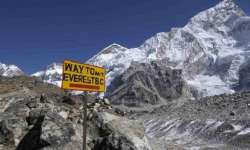Congestion didn't kill climbers on Everest: Nepal
In the statement, the Nepal's Department of Tourism has stated that it had issued 366 expedition permits in 2017 and 346 expedition permits in 2018 - not a huge difference compared to 381 permits issued this year for the highest peak.

Nepal's Department of Tourism (DoT) on Thursday claimed that high altitude sickness and other health reasons caused deaths on Mount Everest this spring season, not congestion.
The DoT's statement has come at a time when it is facing immense criticism for issuing too many permits to scale the world's tallest peak while disregarding the safety of the climbers, reports The Himalayan Times.
"Our attention has been drawn to the wrong information about deaths on Everest conveyed by national and international media," said Dandu Raj Ghimire, Director General of DoT, adding that "traffic jam" did not cause the deaths.
According to Ghimire, the post-mortem reports of the deceased climbers have shown that they died due to high altitude sickness, weakness or adverse weather conditions.
In the statement, the DoT has stated that it had issued 366 expedition permits in 2017 and 346 expedition permits in 2018 - not a huge difference compared to 381 permits issued this year for the highest peak.
"Hence, it untrue that congestion killed climbers on Mt Everest and we urge everyone not to be swayed by false information," the statement added.
Ghimire also expressed his dissatisfaction at the dissemination of such ‘wrong' information in the international media.
"Such false news tarnishes our image and affects our mountaineering sector. Therefore, everyone should think twice before passing such misleading messages in international platform," he added.
According to reports, 11 climbers were reported dead or missing so far this season.
More than 200 mountaineers have died on the peak since 1922, when the first climbers' deaths on Everest were recorded.
The majority of bodies are believed to have remained buried under glaciers or snow.